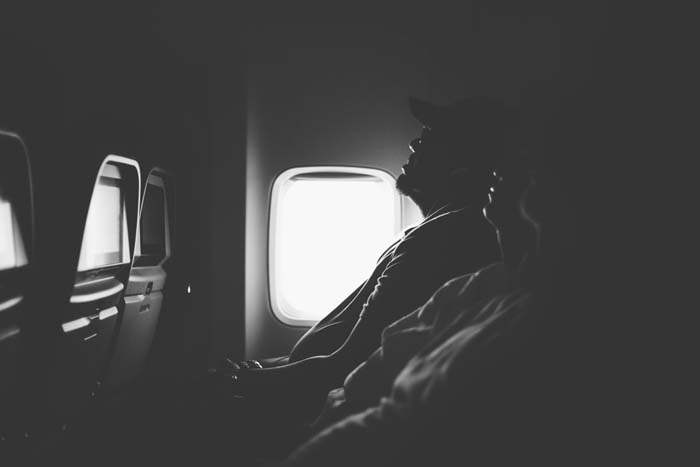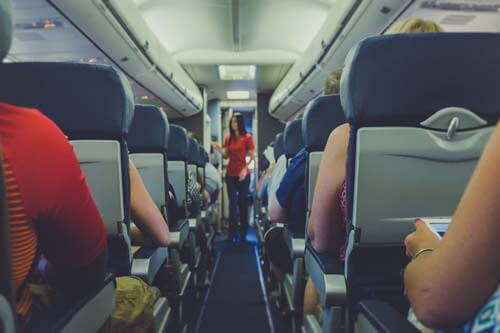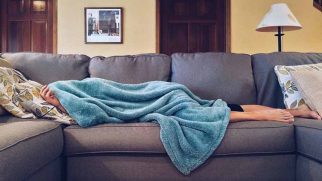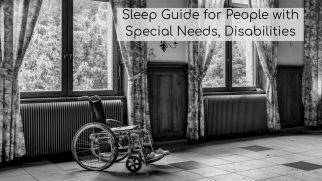How to Sleep on a Plane: 7 Tips to Get Proper Rest Away from Your Bed
by | Last UpdatedTraveling is so much fun…
Unless you have to go long-distance, which involves sleeping on a plane. Or trying to…
I mean, can you sleep when there’s not enough legroom and too many people around?
Actually, yes, you can. There are many things you can do to get some rest during your flight. Curious?
Great! Then let’s find out how to sleep on a plane against all odds.

A Quick Links
Contents
- A Quick Links
- #1 Pick the Best Seat
- #2 Choose Comfortable Clothes
- #3 Consider Sleep Aids
- #4 Think About Your Position
- #5 Make Sure You Don’t Get Disturbed
- #6 Don’t Give Your Routine Up
- #7 Don’t Worry If You Suffer from Insomnia
- What to Take to Sleep on a Plane?
- Tips for Sleeping on a Plane for People Who Snore or Have Sleep Apnea
#1 Pick the Best Seat
And the best plane, if you can. You see, there are many airlines offering comfortable seats in the premium economy and economy classes. Just do your research and find out as much as you can about the level of comfort provided by the airline you fly with. You can use customer reviews too. To know what you should expect.
If you are sticking to the good old Economy class, you can work with what you have. Here are the options:
- The front part of the economy section. All that legroom may seem promising. But did you know that the front seats are usually reserved for passengers with kids? When picking them, it’s like Russian roulette: you may get enough space to stretch your legs out, or you may end up spending hours near never-stopping-crying babies and their never-knowing-how-to-calm-their-baby-down parents. On the other hand, the front is a bit steadier, which is great for people who are afraid of flying. It’s also less noisy (typically), so it’s less likely to freak you out.
- The middle part. Probably the most “neutral” seats, they are far from the toilets and not that close to emergency exits (and potentially noisy kids).
- The back of the plane. The last row seats almost never recline, so that’s something you should keep in mind. Additionally, the back of the plane is where the toilets are, which means constant traffic and potentially unpleasant odors. Nothing about that says “comfort and restful sleep”, don’t you agree?
“Watching what you eat is always a good idea, especially when trying to sleep on a plane. You see, heavy foods (or too much food) will make your stomach feel heavy and might even cause pain and digestion issues. This will hardly let you sleep well.”
- Plane aisle seats. While these give you quick access to the toilets (without the need to disturb your neighbors) and allow you to get your drinks and food first when the flight attendant serves them, they can play a trick on you. Just imagine letting your neighbors through every time they need to go to the restroom. And don’t forget that other passengers will be walking right next to your seat. This definitely will not allow you to sleep comfortably on a plane.
- Window seats. These are quite popular among travelers, and there’s a reason for that. Not only do they give you something to lean your head against but also reduce the number of people near you (thus reducing your chances of being disturbed).
- Seats near the emergency exits. Again, these might seem appealing because of the legroom, but you need to remember that they, just like the back ones, usually do not recline in order not to be an obstruction during the evacuation. Therefore, when picking such a seat, you will have to spend the whole flight sleeping sitting up.
Don’t know about you, but to me, it’s obvious that a window seat is the all-time best option. I always choose this one even if I have to pay extra for that.
#2 Choose Comfortable Clothes
Wearing tight jeans or heals is surely not the best way to sleep on a plane. Go for something soft, warm, and comfy – something that will help you relax and feel more comfortable. Avoid wired bras, small elegant shoes, etc. It’s better to wear an oversized hoodie or sweater, stretchy pants, warm socks, or even a tracksuit.
But note:
You never know what temperature is going to be inside the cabin.
That’s why I usually have my T-shirt on under the hoodie and a pair of flip-flops in my handbag.
Now, some travelers prefer changing in their PJs when the plane takes off. Mind that other passengers might consider this to be… too much. So, unless you want to get on this list of most annoying plane passengers, I suggest you abstain from that.
“If you want to get proper rest when traveling, try to avoid alcohol. Because it is a stimulant, it might keep your brain alert and prevent you from falling asleep.”
#3 Consider Sleep Aids
Sleeping on a plane can be very, very difficult sometimes.  Especially if you are worried about something or scared of flying. In such a case, taking sleeping pills might seem like the most effective way to get some sleep on a plane.
Especially if you are worried about something or scared of flying. In such a case, taking sleeping pills might seem like the most effective way to get some sleep on a plane.
Here’s the kicker, though:
You need to be very careful, especially if you are traveling alone. Take only the medicine you have experience using. You need to know how the pills will affect you and how you are going to feel when you wake up in order to have a safe, comfortable trip.
Now, there are many safe sleep aids, and the most popular among them is melatonin. It helps users doze off even in such a stressful environment as on a plane.
#4 Think About Your Position
Firstly, uncross your legs. Keeping them crossed leads to restricted blood flow, which might make you feel uncomfortable (and lead to some health issues).
Now, the best possible scenario is reclining your seat back as far as it allows for. If the passengers behind you do not do the same, this will leave them little space, so it’s always better to ask first. But don’t worry, on long flights, the majority of travelers recline their seats, so you’re probably not going to annoy anyone. Reclining your seat will take the pressure off your lower back, so you will feel much more comfortable.
If you are a side sleeper, you can try rolling to one side, but try using a pillow to support your neck. Again, on long flights, each passenger usually gets a small pillow and a blanket. If you sleep on your back, you can use that blanket to support your lower back by rolling it and placing under your lumbar area.
If you are normally a stomach sleeper, I have bad news for you, there’s not much you can do (unless you are traveling in First Class where seats can take a fully reclined, horizontal position). My advice is: use the props. Allow your pillow to support your neck. You can also try leaning onto the seat in front of you, but you need a large pillow to support your body for that. Experiment and switch positions until you find the most comfortable one.
In case you’re lucky enough to have no one sitting beside you, don’t be afraid to use the free space and lie down in a horizontal position. From my experience, flight attendants are used to that, so it’s quite normal.
Remember:
You’re not violating any safety rules if you have your seatbelt fastened. Yes, it might be not so easy to fasten the seatbelt when lying, but I’m sure you can deal with that.
And one more thing:
if ear popping during flights is a regular issue for you, you might want to ask a flight attendant to wake you up about an hour before landing. Otherwise, you’re risking to wake up with severe pain in the ear you were lying on or, what’s worse, in both.
Now, for all the ladies flying long haul when pregnant, consider the bulkhead seats that offer enough legroom. It’s also a good idea to take your shoes off and rest your feet on something elevated (your carry-on, for instance). Because pregnancy often causes swelling and leg cramps, it’s also a good idea to take a stroll down the plane aisle every hour or so. You might sacrifice your sleep for that, but at least you will avoid painful cramps.
#5 Make Sure You Don’t Get Disturbed
Now, this may be hard given the fact that other passengers might accidentally wake you up. Still, you can minimize the disturbances by letting your flight attendant know that there’s no need to wake you up for drinks or snacks (if you are planning to sleep through your long flight).
Some airlines offer special stickers saying “Do not disturb” or “Wake me up for snacks only”, which you can attach to your blanket.
It’s also a good idea to buckle your seatbelt on top of your blanket. I learned this the hard way when I was traveling from California to Tokyo. There was some possible turbulence, so the seatbelt sign switched on. A flight attendant woke me up in the middle of the night just to make sure my seatbelt was buckled under my warm, cozy blanket.
#6 Don’t Give Your Routine Up
One of the best ways to relax and prepare yourself for sleep is getting ready for bed the way you usually do at home. This might mimic the comfort you feel when doing that at home, which will help you get into the right mindset for sleep. You can change into something more comfortable, brush your teeth, do a face mask, apply hand lotion, etc. Just anything that makes you feel relaxed.
#7 Don’t Worry If You Suffer from Insomnia
I know, easier said than done.
But there’s one thing you need to know: 
Many insomniacs actually manage to sleep on a plane. How?
Well, this happens because they are away from their regular environment (in which they can’t sleep). A new setting (such as a plane) can actually distract your brain and create a new sleeping environment for your body.
“The direct and non-stop flights are usually more expensive, but they will give you the best chance to get some sleep. You won’t have to leave the plane, wait in the airport, and board a new plane. You can just sit back, relax, and catch a couple of Z’s.”
Additionally, you are free to try all the things you usually do to sleep better at home. Taking melatonin, listening to soft music, meditating, and so on. If one of those things helps you sleep when you’re home, chances are it will do the same when you’re on a plane.
What to Take to Sleep on a Plane?
Well, there are many handy sleep accessories that can become your best helpers on a long-haul flight.
I, for one, cannot survive without a comfortable travel pillow, a pair of noise-canceling earplugs, and a good sleep mask that can block the annoying lights when I want to take a nap.
“The first rule you need to remember is that not all plane seats are good for you. That’s why it is so important to check-in online and pick a proper seat as soon as possible.”
A pair of good noise-canceling headphones is an alternative to earplugs, so you might want to get those instead. Thus, apart from not hearing other people’s voices and sounds of the plane itself, you will also be able to listen to soothing music, guided meditation, or, for instance, nature sounds.
Tips for Sleeping on a Plane for People Who Snore or Have Sleep Apnea
Sleep apnea and snoring are linked. And while each of these conditions can be pretty disturbing during sleep, the combination of them is a real sleep killer.
Still, there are some things you can do to avoid these unpleasant conditions, or at least make them a bit more bearable both for you and for your neighbors. You can try the following:
- Use a C-style travel pillow to provide support for your neck and ensure the proper position of the airways.
- Try allergy treatments and sprays that can reduce nasal congestion.
- Consider taking your CPAP machine (if you are using it for sleep apnea) and inquire about it before the flight. Make sure that there’s an electrical outlet for it.
There also are special oral devices used for moderate and mild cases of sleep apnea. And if you are worried about looking like a “freak” with something like that in your mouth… you really need to think about your priorities. What is more important, getting some sleep or looking “normal” in the eyes of other passengers? It’s up to you to decide.
So, how often do you travel? Do you manage to sleep during flights? You’re welcome to share your secret tips for sleeping on a plane in the comments!





No Comments